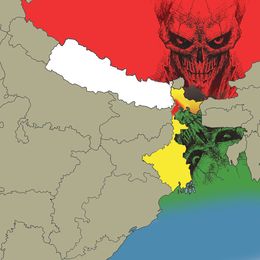There’s an apocryphal story about a Chinese commander having boasted in 1962 that if he were to launch a southward push after breakfast, he could eat his lunch at Siliguri and dinner in Calcutta. The story put the fear of the dragon in Indian generals’ minds; they fortified the Siliguri corridor forthwith, and the whole of north Bengal afterwards, rendering the commissar-commander’s noodle dinner dreams pretty stale. Nine years later, India helped create a Bangladesh, which we could count on to be with us in rain, shine, war, trade and cyclone.
The Siliguri Corridor, 17km wide at its narrowest and bounded by Nepal, Bangladesh and Bhutan, is known as eastern India’s choke point or chicken’s neck. If a Chinese general advances 130km from Chumbi valley and breaks into the corridor, he can cut off India’s northeast from the mainland.
Now Muhammad Yunus of Bangladesh is giving salivating meal ideas to Chinese strategists. In Beijing late last month, he told his hosts that the Banglas are “the only guardians of the ocean for all this region”, and “all this region” could be “an extension of the Chinese economy”. The geostrategic import of the words were grave enough to make Narendra Modi agree to a meeting with the banker-turned Bangla ruler in Bangkok, and tell him to choose his words carefully.
But what’s the big deal? Wasn’t Yunus telling a few truisms in geography? More. He was also giving them lessons in geopolitics. Tactically put, he was telling the Chinese that if they could manage their lunch at Siliguri, he could host them to tea at Banglabandha and dinner at Chittagong. Banglabandha, if you don’t know, is the northernmost town of Bangladesh, just about 19km by road from Siliguri, and less as the drone flies.
Indeed, nothing has changed on the tactical ground. Our defences remain impregnable; the passage from Chumbi is so narrow that the Chinese will have to advance single file, and our boys can cut them down easily; we man the mountain heights, so a Chinese assault would need eight to 20 times more strength. Our guns are in position, our satellites are on the lookout, our radars are scanning the skies; our Rafales and Jaguars in Hasimara and Bagdogra are ready to scramble, our S-400 batteries are on the alert; our BrahMos commanders are peering at targets 300km into Tibet; and our boys are on constant mountain vigil.
But a lot has changed in the strategic ground. How? Will explain.
Armies require room for manoeuvre, and choke points don’t yield an inch of it. Indian commanders had been resting assured with the thought that when the chips are down, and if the Chinese came down the hills, the friendly Bhutan, Nepal and Bangladesh would yield them the room for manoeuvre. Ever since he launched his economic belt-and-road, and India stayed away, Xi Jinping has been seeking to deny the strategic buffers that India had maintained on its frontiers, and the tactical room for manoeuvre that Indian Army had counted on.
Remember Xi’s bid to build a road into Doklam in Bhutan and how violently India reacted in 2017? We launched Op Juniper, sending 270 armed troops with bulldozers to block the Chinese. The Chinese went back, and we ensured that our room for manoeuvre in Bhutan remained ours. Bhutan was our ally, and still is; so our bluff prevailed.
With Yunus, it’s different. One, he isn’t our ally. Two, he is saying: room for manoeuvre? Sorry gentlemen, count me out; any room for manoeuvre in the Bangla land is being leased out to my Chinese friends to trade and prosper.
prasannan@theweek.in


